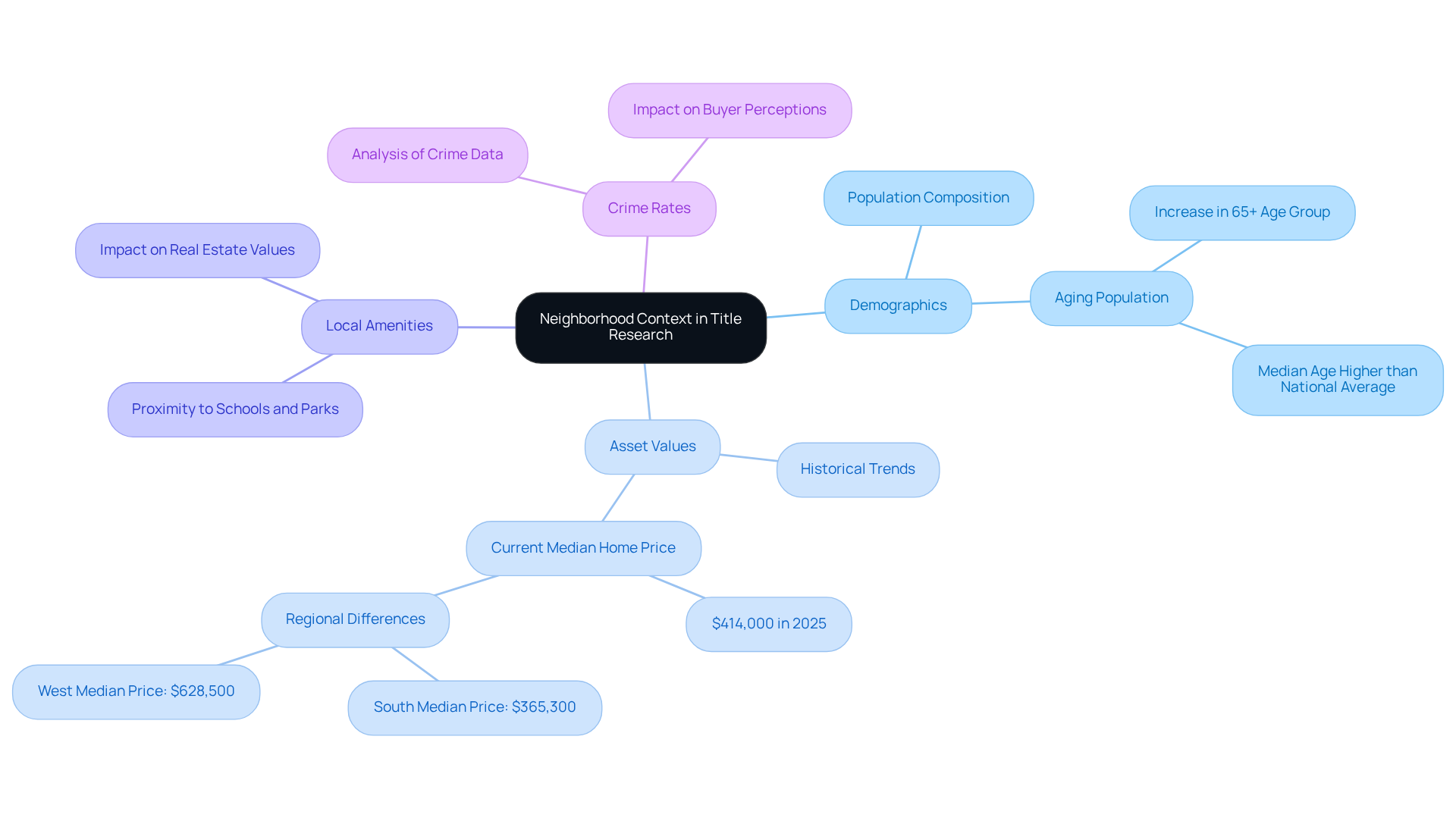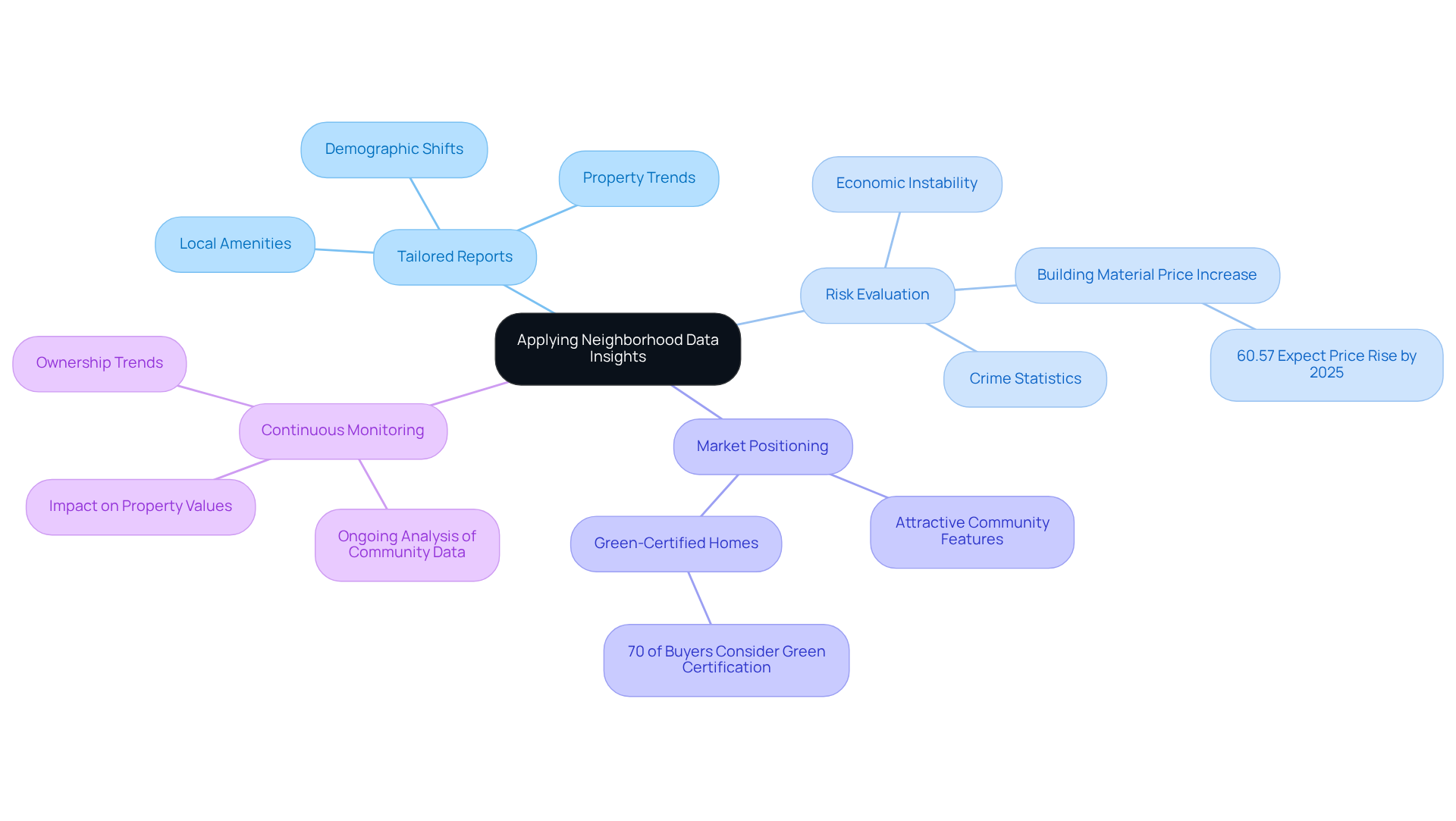Overview
The article centers on three indispensable tools for effectively analyzing neighborhood data:
- GIS software
- Data analytics platforms
- Machine learning algorithms
These tools significantly enhance the capacity to visualize, interpret, and predict community dynamics. Consequently, they empower researchers to make informed decisions grounded in comprehensive data analysis and insights. By leveraging these advanced technologies, stakeholders can navigate the complexities of community dynamics with confidence.
Introduction
Understanding the intricate dynamics of neighborhoods is crucial for title researchers who aim to make informed decisions in real estate. By harnessing advanced tools for analyzing neighborhood data, researchers can uncover valuable insights that drive strategic actions and enhance client offerings. However, with a plethora of data available, the challenge lies in effectively navigating this landscape to discern meaningful trends and avoid common pitfalls. Furthermore, the ability to analyze and interpret this data not only facilitates informed decision-making but also positions researchers as trusted advisors in the industry.
Understand Neighborhood Context in Title Research
To analyze community data effectively, title researchers must utilize and grasp the context of the areas they are investigating. Key factors to consider include:
- Demographics: Understanding the population composition—such as age, income levels, and education—offers insights into the neighborhood's stability and growth potential. For instance, the U.S. population aged 65 and older has increased significantly, indicating a shift in community dynamics that can influence real estate demand. Notably, almost half of U.S. metro areas had a median age higher than the national median of 39.1, which is crucial for understanding neighborhood dynamics.
- Asset Values: Examining historical asset value trends is essential for evaluating current market conditions and forecasting future changes. In 2025, the median home price reached $414,000, reflecting a 1.8% year-over-year increase. Additionally, the South median home price was $365,300, with a year-over-year change of -0.1%, highlighting regional differences that title researchers should consider.
- Local Amenities: Proximity to schools, parks, and shopping centers enhances appeal, directly impacting ownership choices. Real estate experts highlight that local amenities can greatly impact real estate values. As one specialist remarked, "Local amenities are a key factor in determining real estate desirability and can greatly influence market value."
- Crime Rates: Analyzing crime data is essential, as it can shape buyer perceptions and impact real estate values. Regions with reduced crime rates usually experience greater demand, which can stabilize or enhance real estate values over time.
By collecting and examining this information, researchers can develop a thorough profile of the area, which is crucial for precise property research and assessments using tools for analyzing neighborhood data. Furthermore, it is crucial to prevent misunderstanding community information by excessively depending on one statistic without taking into account wider trends.

Utilize Advanced Tools for Data Analysis
To examine community information effectively, title researchers must leverage advanced tools that streamline information gathering and analysis. The significance of accurate title research cannot be overstated; it is foundational for informed decision-making. However, researchers often face challenges in data management and analysis. To address these challenges, several key tools emerge as essential:
- GIS Software: Geographic Information Systems (GIS) tools, such as ArcGIS, empower users to visualize spatial data, facilitating the identification of trends and patterns in neighborhood characteristics. With a substantial market share in real estate analytics anticipated for 2025, remains vital for thorough area assessments.
- Data Analytics Platforms: Platforms like Tableau and Power BI are instrumental in creating interactive dashboards that visualize key metrics, providing quick insights into community dynamics. Data analysts have noted that these tools enhance the effectiveness of neighborhood insights, allowing for more nuanced decision-making.
- Machine Learning Algorithms: Implementing machine learning models automates the analysis of extensive collections, uncovering correlations and predicting property value trends based on previous information. This capability is increasingly vital as the volume of data continues to grow.
- Optical Character Recognition (OCR): Utilizing OCR technology expedites the extraction of relevant information from document titles, significantly enhancing the efficiency of the research process. This integration enables researchers to finalize abstracts and reports more swiftly and precisely.
By integrating these advanced tools into their processes, researchers can significantly enhance their analysis capabilities. Consequently, this results in more informed and strategic decision-making.

Apply Insights from Neighborhood Data Effectively
Once community data has been thoroughly examined, researchers must apply these insights effectively within their workflows. Here are several strategies for optimal application:
- Tailored Reports: Create customized reports for clients that highlight crucial neighborhood insights, such as property trends, demographic shifts, and local amenities, to support informed decision-making. This tailored approach not only enhances client understanding but also aligns with the that Parse AI provides compared to traditional title research methods.
- Risk Evaluation: Utilize community information to evaluate potential hazards linked to ownership, including crime statistics and economic instability. For instance, with 60.57% of individuals anticipating a rise in building material prices by 2025, it is imperative to communicate these risks to clients effectively.
- Market Positioning: Leverage insights to position real estate strategically within the market, emphasizing attractive community features that entice buyers. Notably, over 70% of buyers consider green-certified homes, which can significantly enhance marketability.
- Continuous Monitoring: Establish a robust system for ongoing analysis of community data to remain informed about changes that may impact property values and ownership trends. This proactive approach empowers researchers to provide timely guidance to clients.
By effectively applying neighborhood insights and using tools for analyzing neighborhood data, title researchers can significantly enhance their service offerings and deliver greater value to their clients, thereby demonstrating the efficiency and innovation that Parse AI embodies.

Conclusion
Understanding neighborhood dynamics is crucial for title researchers aiming to make informed decisions in real estate. This article emphasizes the importance of analyzing various factors, including demographics, asset values, local amenities, and crime rates, to build a comprehensive understanding of the area being researched. Furthermore, by leveraging advanced tools such as GIS software, data analytics platforms, and machine learning algorithms, researchers can enhance their data analysis capabilities and ultimately provide more strategic insights.
Key insights discussed throughout the article highlight the need for tailored reports, risk evaluations, and continuous monitoring of community data. These strategies not only improve the quality of service provided to clients but also empower researchers to adapt to evolving market conditions. The integration of these insights into real estate practices underscores the significance of thorough neighborhood analysis in achieving successful outcomes.
In conclusion, the effective application of neighborhood data is essential for title researchers to navigate the complexities of the real estate market. By embracing advanced analytical tools and implementing strategic insights, researchers can significantly elevate their contributions, ensuring that clients receive the most accurate and relevant information. This commitment to data-driven decision-making not only enhances the value of real estate transactions but also fosters a deeper understanding of community dynamics that can shape the future of neighborhoods.
Frequently Asked Questions
Why is understanding neighborhood context important in title research?
Understanding neighborhood context is crucial in title research because it helps researchers analyze community data effectively and grasp the dynamics of the areas they are investigating, which can influence real estate demand and property values.
What demographic factors should title researchers consider?
Title researchers should consider factors such as age, income levels, and education of the population. These demographics provide insights into the neighborhood's stability and growth potential.
How do asset values impact title research?
Examining historical asset value trends is essential for evaluating current market conditions and forecasting future changes. For example, the median home price in 2025 was $414,000, reflecting a year-over-year increase of 1.8%.
What role do local amenities play in real estate?
Local amenities, such as proximity to schools, parks, and shopping centers, enhance the appeal of a neighborhood and directly impact ownership choices and real estate values.
Why is it important to analyze crime rates in neighborhood research?
Analyzing crime data is essential because it shapes buyer perceptions and can significantly impact real estate values. Regions with reduced crime rates typically experience greater demand, stabilizing or enhancing property values over time.
How can title researchers avoid misunderstandings in community information?
Title researchers can avoid misunderstandings by not excessively relying on one statistic and instead considering a broader range of trends and data to develop a comprehensive profile of the area.




